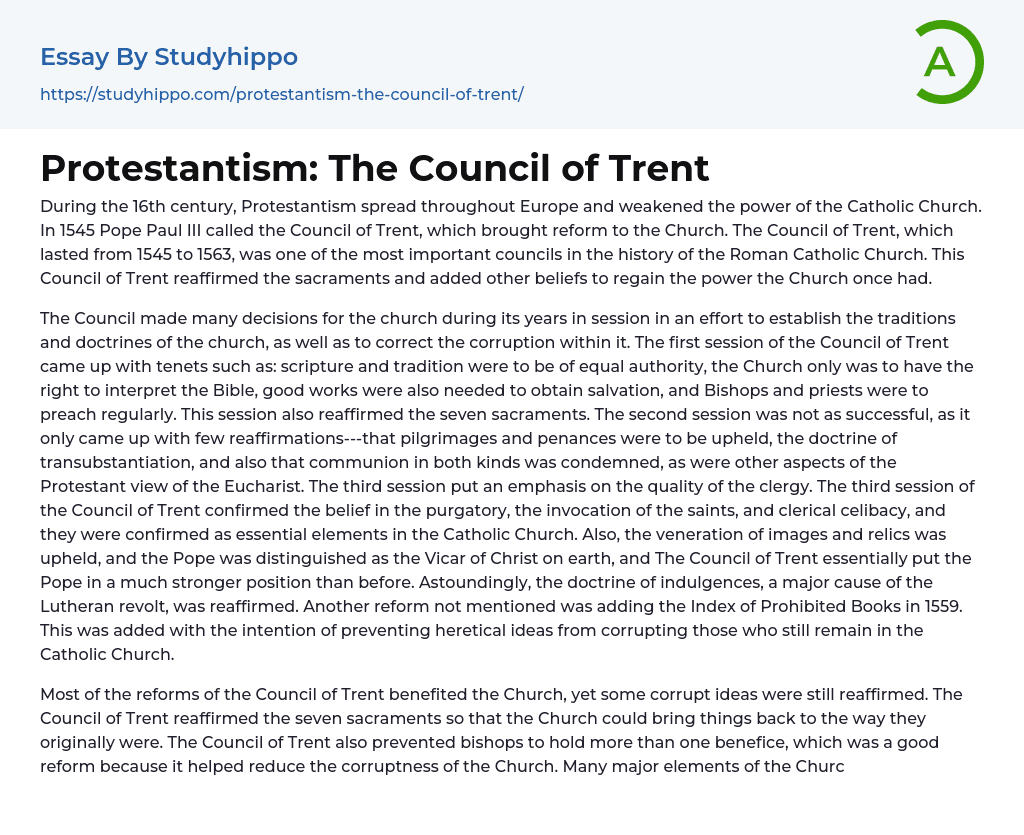During the 16th century, Protestantism spread throughout Europe and weakened the power of the Catholic Church. In 1545 Pope Paul III called the Council of Trent, which brought reform to the Church. The Council of Trent, which lasted from 1545 to 1563, was one of the most important councils in the history of the Roman Catholic Church. This Council of Trent reaffirmed the sacraments and added other beliefs to regain the power the Church once had.
The Council made many decisions for the church during its years in session in an effort to establish the traditions and doctrines of the church, as well as to correct the corruption within it. The first session of the Council of Trent came up with tenets such as: scripture and tradition were to be of equal authority, the Church only was to have the right to i
...nterpret the Bible, good works were also needed to obtain salvation, and Bishops and priests were to preach regularly. This session also reaffirmed the seven sacraments. The second session was not as successful, as it only came up with few reaffirmations---that pilgrimages and penances were to be upheld, the doctrine of transubstantiation, and also that communion in both kinds was condemned, as were other aspects of the Protestant view of the Eucharist. The third session put an emphasis on the quality of the clergy. The third session of the Council of Trent confirmed the belief in the purgatory, the invocation of the saints, and clerical celibacy, and they were confirmed as essential elements in the Catholic Church. Also, the veneration of images and relics was upheld, and the Pope was distinguished as the Vica
of Christ on earth, and The Council of Trent essentially put the Pope in a much stronger position than before. Astoundingly, the doctrine of indulgences, a major cause of the Lutheran revolt, was reaffirmed. Another reform not mentioned was adding the Index of Prohibited Books in 1559. This was added with the intention of preventing heretical ideas from corrupting those who still remain in the Catholic Church.
Most of the reforms of the Council of Trent benefited the Church, yet some corrupt ideas were still reaffirmed. The Council of Trent reaffirmed the seven sacraments so that the Church could bring things back to the way they originally were. The Council of Trent also prevented bishops to hold more than one benefice, which was a good reform because it helped reduce the corruptness of the Church. Many major elements of the Church were also reaffirmed to, yet the Doctrine of Indulgences was also reaffirmed. Although this doctrine was not entirely corrupt in nature, it still shows that the Church wanted as much money as it could get.
The Council of Trent made many decisions for the church as an effort to establish the traditions and doctrines of the Church, as well as to correct the corruption within it. It was partially a reaction to issues raised by Protestant reformers. The reforms of the Council of Trent generally strengthened the Church, and made many Catholics confident in their religion.
- Adam And Eve essays
- Baptism essays
- Catholic Church essays
- Christian essays
- Church essays
- Crucifixion Of Jesus essays
- Crusades essays
- Elizabeth essays
- Eucharist essays
- God The Father essays
- Holy Spirit essays
- Jesus Christ essays
- Lord essays
- Pope essays
- Priest essays
- Protestant Reformation essays
- Protestantism essays
- Sacrament essays
- Civil Disobedience essays
- Montgomery Bus Boycott essays
- Protest essays
- Urbanization essays




